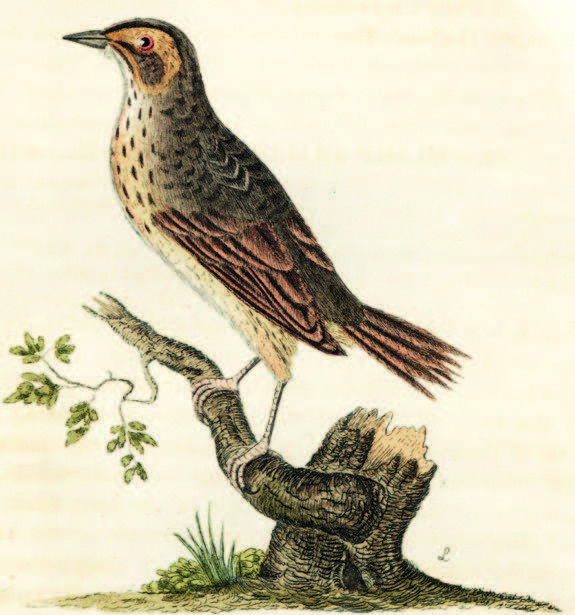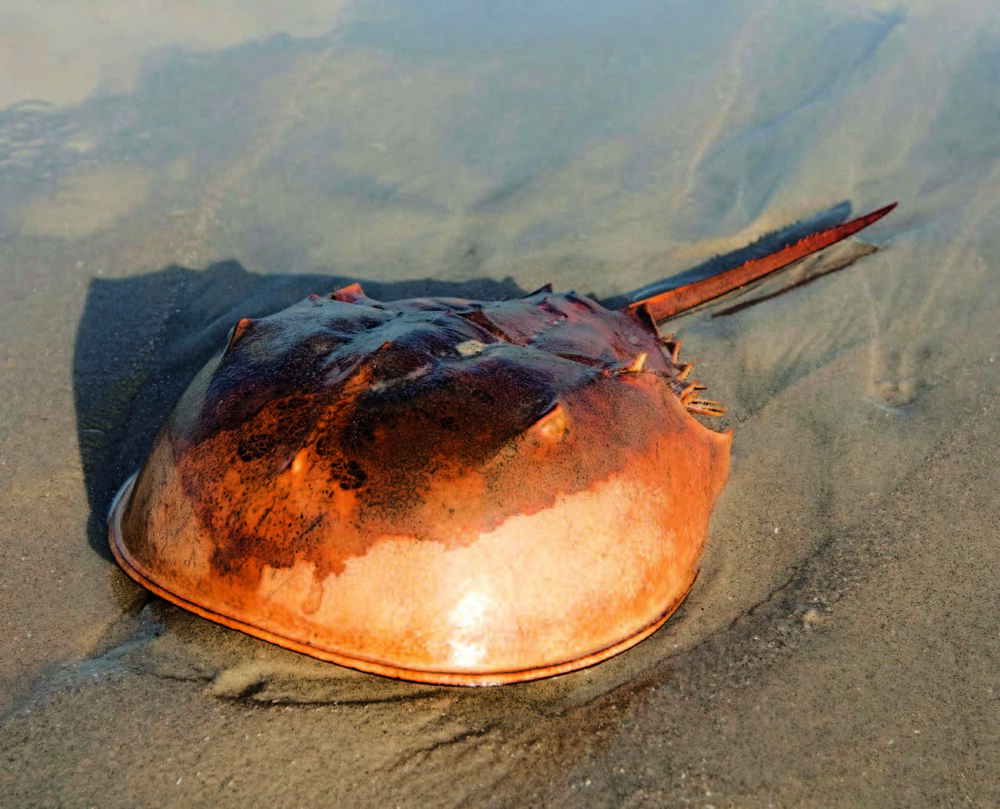Living on the Line
Fighting to Save the Space Between Land and Sea
By Sarah FrancisThe salt marsh sparrow is rapidly losing habitat to sea level rise. Science History Images / Alamy Stock Photo
Scientists and volunteers fight to save saltmarsh sparrows and horseshoe crabs, which inhabit that shrinking space between the sea and the land.

The saltmarsh sparrow is rapidly losing habitat due to sea level rise. Science History Images / Alamy Stock Photo
Every summer morning, by 5:25 a.m., Deirdre Robinson climbs on her bicycle and pedals the mile from her home in Bristol to peaceful Jacob’s Point Salt Marsh in Warren. Owned by the Warren Land Conservation Trust, the marsh is 35 acres of feathery grasses and small, leafy bushes about 4 feet high, hemmed in by the East Bay Bike Path to the east. Channels of saltwater meander throughout like fingers from Narragansett Bay, which borders the marsh to the west.
This watery meadow is home to ospreys, who reside on a nesting platform, and purple martins, lured by a gourd nesting array, as well as to white-tailed deer. Robinson has been fascinated by birds since she was 4 years old in Oklahoma and rescued a mourning dove on the sidewalk. “I knew to be gentle with it,” she says.
But Robinson is not here to see the ospreys and martins. The object of her affection stands roughly 3 inches high and has orange eyebrows, an orange beard, and brown, mottled feathers. It is not especially monogamous and does not defend its turf. It does not sing. In fact, the sound that comes out is more like a whispery “screek.” And it is very particular about where it lives—in fist-size nests built in grasses a mere inch or so above the marsh’s waters.
There’s no question the saltmarsh sparrow is one unusual bird. “That’s why I’m so passionate about it,” Robinson says. “There’s no other like it in the world.”
But despite the saltmarsh sparrow’s healthy population and charismatic personality, fate in the form of climate change is coming for it. Though it has lived in the marshes of the Eastern Seaboard for centuries, its numbers are dwindling by 9% a year, landing it on the Cornell Lab of Ornithology’s Red Watch List.
“This species is in very real danger of extinction in the next few decades,” the list warns. By 2050, it could be wiped off the face of the planet, its habitat washed away by coastal erosion and rising ocean temperatures.
The National Oceanographic and Atmospheric Administration (NOAA) says the sea level measured in Newport has risen more than 9 inches since 1930. That’s faster than the global average, and it could climb another 1 to 4 feet by 2100. Flooding and erosion have become commonplace for shoreline communities like Warren, and this region is undergoing intense saltmarsh loss. Jacob’s Point is Exhibit A.
On those early mornings from May through August, Robinson and her intrepid fellow volunteers visit the marsh’s rich habitat. They’re checking on the well-being of the roughly 60 sparrows and their nests, banding hatchlings, and scanning for predators like hawks.
By 8 a.m. at the latest, before the bugs come out, their work is done. “The heat becomes intolerable,” Robinson says. “There’s no shade, plus there’s humidity.” As members of the Saltmarsh Sparrow Research Initiative (SALSRI), the volunteer researchers, ages 10 to their mid-70s, have studied the sparrow’s breeding habits and life in the marsh since 2016.
“WE WILL NEED EXTREME CONSERVATION MEASURES TO CHANGE ITS TRAJECTORY”
“The greatest threat to the survival of this species is loss of critical habitat,” the SALSRI website cautions. “Nests are flooding due to sea level rise, secondary to global warming. As the marshes experience more frequent and higher-elevation flooding events, these ground-nesting birds cannot possibly alter their genetic blueprint in time to evolve a new nest-building strategy. They don’t even have the option to migrate to higher ground within the marsh, as marshes are disappearing at an alarming rate.”
Salt marshes migrate to higher ground as sea level rises, but when this migration is blocked by infrastructure such as roads and sea walls, marshes succumb to higher water levels, essentially drowning in place. The implications of the sparrow’s plight are clear.
“It didn’t need to happen,” Robinson says. “We did this.”
Steve Reinert, another SALSRI volunteer, is equally emphatic. “The saltmarsh sparrow is an indicator species. It’s not the only indicator of what’s happening in the marsh, but it represents what’s happening overall. If we lose this sparrow, we’ll lose other creatures as we lose the marshes. Both globally and here, decision-makers haven’t responded adequately to warnings of sea level rise. I’m not going to say it’s too late, but we’ll need extreme conservation measures to change its trajectory. Land conservation is our best hope.”
In what Robinson describes as a Hail Mary pass, SALSRI is awaiting permission from the state’s Department of Environmental Management (DEM) and U.S. Fish and Wildlife Service to move roughly 20 sparrows’ nests at the highest risk of flooding in the marsh.
This summer, nests will be lifted a few centimeters above the point where they’re at most risk of being inundated by high tides. Results will be shared with other stakeholders along the East Coast, and SALSRI volunteers will be assisted by a paid summer intern funded by the Narragansett Bay Estuary Program. “Candidates should be willing to arrive at daybreak and work in a hot environment with many insects,” the job description says, in part.
Robinson says she’s optimistic about the commitment she’s seen in the teenage interns she’s worked with, despite the early hours and the bugs. With their burgeoning interest in learning conservation skills, they are our scientific future, she notes. Local efforts like this summer’s nest relocation, plus encouraging younger participatory scientists to pursue their interests as a career, can make a long-term difference to the planet, she says.
As perilous as the future appears for the saltmarsh sparrow, it is even more complicated for horseshoe crabs—the weirdly prehistoric-looking, 2-foot marine arthropods with helmet-like shells and 12 legs—who are more directly related to spiders than shellfish.
The horseshoe crab population is threatened by climate change: Massachusetts Wildlife ranks them highly vulnerable. On top of that, they are harvested as bait food for the eel and conch industries. And their sky-blue-colored blood, which contains a clotting agent, is used to test medical devices and injectable drugs for toxins. In those instances, crabs are caught, bled, and returned to the ocean—at a 30% mortality rate.
Like many states, Massachusetts and Rhode Island regulate their crab populations and conduct regular surveys to determine the best conservation policies. At times, the late-night setting for these assessments can seem a little surreal. Lured from their estuary homes in the spring, the crabs lumber out of the ocean at high tide, looking for love on a moonlit night in May and June. They slowly make their way up the Napatree Point Beach by the hundreds, where they’ll spawn multiple times in the next few hours and days.
“It’s pretty cool,” says Katie Rodrigue, a DEM marine biologist, who sports a miner’s headlamp on those late evenings. “You see the males first come onto the beach and wait for females to approach, then they latch on and mate.” Hanging around on the fringes, the satellite males, as wingmen, take an opportunity to sneak in and spawn as well. “One night, I saw almost 1,200,” Rodrigue says. “It was neat to see such a dense spot. They’re almost in a pile, the females digging in to lay their eggs. It’s not quite a carpet, but you have to be careful you don’t step on them.”
As the tide goes out, the spawning recedes as well. The females lay tens of thousands of eggs in little nests in the sand, five to 10 inches deep. Tiny juveniles emerge from the sand a few weeks later, then swim out to sea with the next moon’s cycle.
Only a very small number will survive after they hatch. Burrowing animals can find and eat them, or waves can wash the larval crabs to the surface of the sand, leaving them vulnerable to other predators, like migratory birds.
Rodrigue is unsure whether there are fewer baby horseshoe crabs spawned to begin with. “We walked along the shoreline looking towards the water and counted to see how many there were, to see if there were trends in spawning densities. We don’t have a lot of evidence that populations are going up or down,” Rodrigue says.
However, a NOAA report concludes that climate change will likely have a high effect on these crabs.
“Sea level rise will reduce spawning habitat. Warming will negatively affect egg and larval survival and thereby reduce productivity.”
Is it possible to get a better sense of the future of these Atlantic species of crabs, which have been around since before the dinosaurs?
“It’s kind of hard to make predictions,” says Rodrigue, who monitors both Napatree and Conimicut points. “We look at all the data sources we have to understand and make projections with. It’s one of those species that seems to be declining. They like to come back to the same place to spawn … That makes them more vulnerable if their habitat changes.”

Horseshoe crabs have been around for millennia, spawning in the same place each year. Photograph by Robin Chittenden / Alamy Stock Photo
Sara Grady, a senior coastal ecologist at Mass Audubon, has also conducted a late-night survey watch, this one in Duxbury Bay on the South Shore. Horseshoe crabs have a very advanced vision of how prehistoric they are. This allows them to distinguish dark objects against a dark background, but they do try to latch onto your feet.”
Grady also nods to how these crabs have hardly changed over millennia, but if their environment is altered, they may struggle to find suitable places to spawn.
“They need to bury their eggs, so it can’t be a place where there isn’t sediment to dig into, but it has to be sediment where the eggs won’t rot,” she says. “If they’re laying in a higher part of the beach at high tide, it’s oxygenated, which is good.”
Horseshoe crabs have survived 450 million years, she says, but humans have had a negative impact in the last few decades in a host of ways.
Mass Audubon is pushing for stronger protections for horseshoe crabs, she says. “Bait harvest has had the predominant impact, and the lesser impact is in the biomedical application.”
As for habitat loss, “we haven’t quantified that effect yet,” Grady says but adds that climate change “will reduce their spawning habitats, and in some instances, there may not be any additional place to go because they run up the beach to a sea wall or someone’s property. I noticed with my survey that wind speed and direction may affect how they spawn. If climate change alters wind speed, it could negatively affect spawning. They don’t like choppy weather.”
David Gregg is the executive director of the Rhode Island Natural History Survey. It’s a small, member-supported nonprofit that has educated the public about the state’s animals, plants, and the natural world since 1994. From his modest office in South Kingstown, Gregg is overseeing the updating of a giant database of rare, local species, recently funded by the Rhode Island Foundation. A working prototype is expected to be completed later this year.
Originally managed a couple of decades ago by the DEM and The Nature Conservancy and sporadically updated since, the database, which includes a massive Excel spreadsheet, tracks more than 500 at-risk and rare native plants and animals, among them the ringed boghaunter dragonfly and the small whorled pogonia orchid. Once updating is finished, the nonprofit can respond to questions from professionals and agencies. Also, staff will enter into the database the new rare species observations they receive each year. Eventually, the plan is to allow the public to have online access, although they will not have access to information on exactly where the species can be found, Gregg says. “We don’t want to worry about poachers looking for box turtles.”
Once it is up and running, the database will be an invaluable research tool for protecting vulnerable species like the saltmarsh sparrow and horseshoe crab. It will provide information on the many local plants and animals that are threatened if their numbers are changing, and how they can be protected. In a larger sense, it should prove critical in tracking the state’s trends in biodiversity.
As Gregg points out, widespread vigilance is key. “Vanishing species are trying to tell us something,” he says. “Once people notice a species isn’t around, it’s probably too late.”
Narragansett Bay Estuary Program
This issue is supported by the Narragansett Bay Estuary Program (NBEP), a nonprofit organization led by stakeholders that pursues place-based conservation across the three-state Narragansett Bay region.
With its 30-member partnership, NBEP catalyzes scientific inquiry and collective action to restore and protect the region’s water quality, wildlife, and quality of life.
This issue of 41°N highlights several of the stories and partners driving a 10-year blueprint to realize their vision of clean water and habitat to sustain all who live, work, and play in the Narragansett Bay region.
